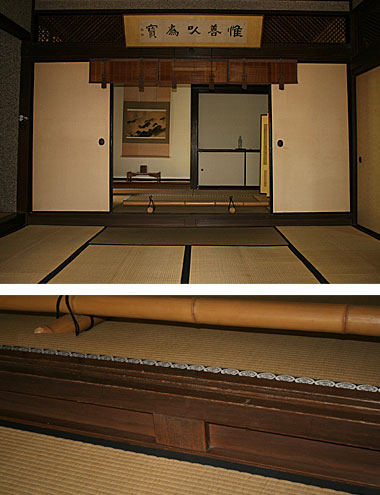|
||
 |
||

Nagatomi
ix house (Hyougo)
@
(C)2001 Japanese Architecture and Art Net Users System.@No reproduction or republication without written permission.
fΪΜeLXgEΚ^ECXgΘΗASΔΜRecΜ³f‘»E]ΪπΦΆά·B
|
||||||
| @ | ||||||
| joudan@γi | ||||||
| KEY WORD :@architecture / aristocratic dwellings | ||||||
| @ | ||||||
| A dais
or a part of the floor in aristocratic dwellings of the *shoin @ style, that was elevated a step higher than the general flooring. The room
in which the joudan is found is also called the joudan-no-ma
γiΜΤ, and is the place where the person of highest rank sits. The remaining
floor space is called the *gedan
Ίi or lower step area. In halls where shogun addressed daimyou
εΌ and their highest ranking retainers, a middle stepped area *chuudan
i was constructed between the joudan and gedan. Surrounding
the joudan, in the most formal shoin halls, were a decorative
alcove *tokonoma
°ΜΤ and with staggered shelves *chigaidana
α’I. On the outer wall was a desk-like arrangement tsukeshoin t@
and on the opposite wall were elaborate decorative doors *choudaigamae
δ\¦. The ceiling above the joudan is coved, coffered and finely
latticed *oriage
kogumi goutenjou άγ¬giVδ. Before the Muromachi period
only wooden plank flooring was used for joudan. Individual mats in
varying sizes and thicknesses, and bound in various colors with fabric,
were assigned to personages according to their rank. When straw mats *tatami
τ were introduced to cover the entire floor, the previous mat-system of
indicating rank became ineffective, and the solution was to elevate the
floor as described above. A famous example was the Oohiroma εLΤ of Nijoujou
ρπι, Kyoto (built 1600), where Tokugawa Ieyasu ΏμΖN (1542-1616) held audiences with
the court and military. Large rural dwellings *minka
―Ζ also gradually began to have a joudan after the Momoyama period;
Minka were the homes of village headmen and sake brewers, as well
as accommodating first class inns, etc. The Furui Γδ residence (15-16c,
Hyougo prefecture) has a joudan-no-ma as well as the Yakake Inn (17-19c,
Nara). The shoin style was used here to accommodate high
ranking noblemen and daimyou. |
||||||
| @ | ||||||
 Nagatomi
ix house (Hyougo)
|
||||||
@ |
||||||
| REFERENCES: | ||||||
| @ | ||||||
| EXTERNAL LINKS: | ||||||
| @@ | ||||||
| NOTES: | ||||||
| @ | ||||||
(C)2001 Japanese Architecture and Art Net Users System.@No reproduction or republication without written permission. fΪΜeLXgEΚ^ECXgΘΗASΔΜRecΜ³f‘»E]ΪπΦΆά·B |
||||||
| @ |